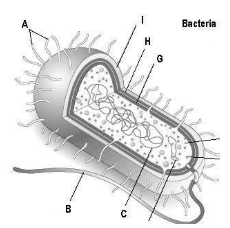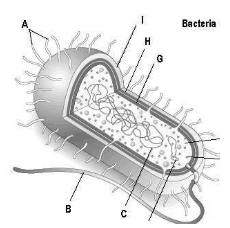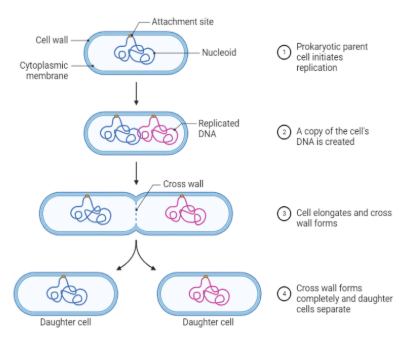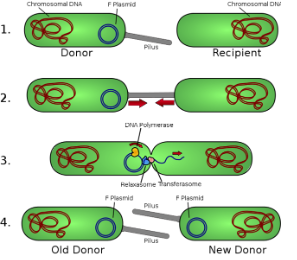Biology - Gr.11 🦁 (UNIT 2: DIVERSITY) - Bacteria
1/54
There's no tags or description
Looks like no tags are added yet.
Name | Mastery | Learn | Test | Matching | Spaced |
|---|
No study sessions yet.
55 Terms
Pili (fimbria)
small hairs that help the bacteria stick to other cells and surfaces, used for conjunction
Flagellum
type of tail that helps the movement of bacteria
Capsule (slime layer)
sticky material that reduces water loss, resists temperature and blocks Ab and viruses
Cell wall
mainly composed of peptidoglycan to create a rigid and protective wall
Plasma (cell membrane)
plasmic membrane forms a barrier b/w the cell and its environment; has selective permeability
Plasmid
small loop of DNA, can carry genes that produce Ab resistance *responsible for mutations
Ribosomes
organelles responsible for protein synthesis
Inclusions
particles of aggregated protein. Important function in the metabolism of bacteria and viral replication
Chromosome
large chromosomal lop of genetic information (DNA) necessary for the normal function of the cell found in the nucleoid region

Label this diagram
A: Pili
B: Flagella
C: Nucleotide (DNA)
D (lower arrow/not labelled): plasmid
E(right): cytoplasm
F(right): ribosomes
G: Cell membrane
H: Cell wall
I: Capsule

What are the THREE layers of Bacteria?
capsule
cell wall
plasma membrane (cell membrane)
What are the THREE common shapes of bacteria?
coccus
bacilli
spirilla
COCCI
→ sphereical (round-shaped) bacteria
coccus
diplococci
streptococci
staphylococci
BACILLI
→ rod-shaped bacteria – they look like little sticks or straight capsules under a microscope.
bacillus
diplobacilli
streptobacilli
SPIRILLA
→ spiral-shaped bacteria. They look like corkscrews or wavy lines under a microscope.
Gram staining techniques
Gram-Positive (+)
thick protein that stains purple
more susceptible to antibiotics
many causes diseases
Gram-Negative (-)
thin layer of protein which stains pink
complex layer (blocks antibiotics)
How does the Gram staining technique work?
Purpose: used to tell the difference between two types of bacteria based on their cell wall structure
Why would the cell wall turn purple?
thick peptidoglycan layer holds the purple dye
Why would the cell wall turn pink?
thin wall + outer membrane loses purple, takes up red dye instead (thin layer)
Bacteria can live WITH or WITHOUT oxygen with what aerobes?
Obligate aerobes
Facultative anaerobes
Obligate anaerobes
Obligate aerobes
must HAVE OXYGEN available to survive (such as animals & plants)
Facultative anaerobes
CAN live WITH or WITHOUT oxygen
Obligate anaerobes
CANNOT live in the PRESENCE of oxygen
What are endospores
→ a rigid wall that can be formed (a protective structure)
under favorable conditions, bacteria will condense its chromosomes and all the other necessary components (wrapping them inside a rigid and resistant wall)
other components of the cell will disappear, leaving a small endospore that can withstand extreme environments for long periods of time
Reproduction in bacteria
Asexual reproduction by: Binary Fission

Binary Fission
→ where a single parent cell divides into two identical daughter cells
Prokarytotic parent cell initiates replication
A copy of the cell’s DNA is created
Cell elongates and cross wall forms
Cross wall forms completely and daughter cells seperate
*takes only 20 mins

Conjugation
→ A form of sexual reproduction in which 2 cells share genetic information when one cell copies a gene from a plasmid and transfers is intiated when cilili (pili) attach

Transformation
→ a complete strand of DNA is transferred from dead bacteria (or from the environment) to a living bacteria
→ Physical contact is NOT required
→ A newly “transformed” bacteria can now perform the funnctions of a dead bacteria ex. can now become pathogenic (disease-causing)
What are some bacterial diseases?
Diptheria, cholera, tetanus, leprosy, strep throat, tuberculosis, botulis, potato ring rot
Who discovered antibiotics and how?
→ Alexander Fleming by accident in 1928
→ Observing a contaminated petri dish, the Penicillium mould released a toxin that inhibited the growth of bacteria in a petri dish. This was called ‘penicillin’
→ Disadvantage: can kill beneficial bacteria and if used incorrectly, development of ‘antibiotic resistant bacteria’
What is antibiotic resistance?
→ Antibiotics are designed to to kill most bacteria but sometimes, a few bacteria develop a mutation that helps them survive the antibiotic. These surviving bacteria multiply and pass on the resistant and overtime, causing more bacteria to become resistant. This causes the problem of infections becoming harder to treat.
Antibiotics
→ can be used to kill bacteria
→ These are chemical compounds produced by certain strains of bacteria or fungi
Do viruses belong to a kingdom? True or false?
False
Are they alive or not?
→ NON-LIVING!! They need a host to reproduce and they don’t have distinctive organelles
Viruses that infect bacteria are called ____
bacterrophages
→ This process is called TRANSDUCTION
How do infections occur?
→ All viruses work by forcing the host cell to make hundred or thousands of copies of themselves (as this takes place, host cell is able to perform normal functions and results in an ‘infection’)
When an infection spreads locally, it’s called ____
an epidemic
When an infection spreads globally, it’s called ____
a pandemic
What does some viruses contain?
nucleic RNA instead of DNA
→ RNA causes most serious diseases
Diseases caused by DNA virus
EXAMPLE: hep B, cold sores, chicken pox, tumours
Diseases caused by RNA virus
EXAMPLE: measles, mumps, polio, HIV (AIDS), colds, rabies
What are two ways phages reproduce?
Lytic Cycle
Lysogenic Cycle

Lytic cycle
“Fast and destructive”
The virus enters a cell, takes over, and makes lots of copies of itself.
Then it bursts (lyses) the cell open, releasing new viruses.
The cell dies.
The host cell is completely destroyed by _____
Lysis
Reproduction is fast in ____
the lytic cycle
In animal cells, the ____ enter the host
full virus
Steps in the lytic cycle
Binding (attachment)
Entrance
Replication
Assembly
Lysis and Release
1.Binding (attachment)
proteins on the surface of the virus attach to protein receptors on the surface of the host cell membrane
2.Entrance
The virus injects its genetic material (RNA or DNA) into the host cell or the full virus enters
3.Replication
The host cell makes more DNA or RNA and proteins
4.Assembly
New viral particles are assembled
5.Lysis & Release
The host cell bursts and releases new viruses

Lysogenic cycle
“Sneaky and slow”
The virus enters a cell but instead of attacking, it hides its DNA inside the cell’s DNA.
The cell copies the viral DNA whenever it divides.
The virus can stay hidden for a long time.
Later, it can switch to the lytic cycle and destroy the cell.
Vaccine
A vaccine is a weakened or inactive version of a virus or bacteria (or just a small piece of it) that’s injected into your body.
How do vaccines work?
Your immune system detects the vaccine as a “foreign invader.”
It produces antibodies – special proteins that attack the invader.
Your body also makes memory cells that remember how to fight that invader in the future.
If the real virus enters your body later, your immune system recognizes and destroys it quickly, so you don’t get sick (or not as badly).